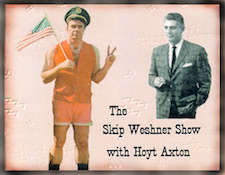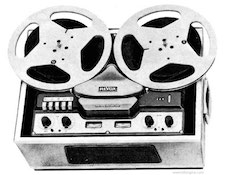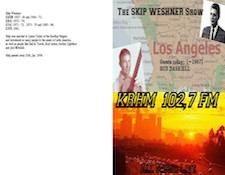It’s the time of year for saving money!
Once I had become a Hi-Fi Crazy and started building a System, I thought it only natural that I should want to make it as complete as possible. That meant that not only did I have to have a record player, but also a tape recorder and an FM tuner. And once I had the tuner, it was only natural that, after 1957 when his program first hit the airwaves, I should listen to Skip Weshner’s program, “Accent on Sound”, which aired five nights a week on KRHM FM, here in California.
 Skip was the ultimate eclectic, and had the broadest ranging musical taste I have ever encountered. He also was about the best-connected man I’ve ever known – at least in the music industry – and seemed to know, and to have, live and performing on his show, just about anybody who was anybody at the time, including Joan Baez, Bob Dylan (back even before he WAS Bob Dylan), Gordon Lightfoot, Hoyt Axton, the Paul Horn Quartet, Maya Angelou, Theo Bikel, Bud & Travis, and any number of others, all of whom Skip recorded either at the station’s studios or in the living room of his Hollywood home and sent-in on tape or by a live-hookup.
Skip was the ultimate eclectic, and had the broadest ranging musical taste I have ever encountered. He also was about the best-connected man I’ve ever known – at least in the music industry – and seemed to know, and to have, live and performing on his show, just about anybody who was anybody at the time, including Joan Baez, Bob Dylan (back even before he WAS Bob Dylan), Gordon Lightfoot, Hoyt Axton, the Paul Horn Quartet, Maya Angelou, Theo Bikel, Bud & Travis, and any number of others, all of whom Skip recorded either at the station’s studios or in the living room of his Hollywood home and sent-in on tape or by a live-hookup.
With all of the vast treasure of live performance being aired, it wasn’t long before I took to taping every one of his “live” shows and, later, after he and I had met and become friends, and I started getting invitations to his broadcast sessions, it also wasn’t long before I became interested in professional recording and started buying recording equipment of my own. (Some years later, I even had a brief but exciting experience as “Junior Engineer” [probably just a nicer word for “Gofer”], helping Jimmy Valentine, do some of the Stan Kenton Big Band recordings at Valentine Sound Recorders in North Hollywood, California).
 What Skip had used for his recordings for broadcast (remember that this was well before stereo FM broadcasting became common) was a Revox tape recorder and (usually) a single Capps condenser microphone. I thought that was just fine for what Skip was doing, but (remember, also that stereo records were introduced in 1957 and that stereo tape – even for home use – had been around for at least several years before that) what I dreamed of and lusted after for myself was something that actually (sort of) came about (but not for me) some years later.
What Skip had used for his recordings for broadcast (remember that this was well before stereo FM broadcasting became common) was a Revox tape recorder and (usually) a single Capps condenser microphone. I thought that was just fine for what Skip was doing, but (remember, also that stereo records were introduced in 1957 and that stereo tape – even for home use – had been around for at least several years before that) what I dreamed of and lusted after for myself was something that actually (sort of) came about (but not for me) some years later.
What I wanted (and what, in my youthful ignorance, I thought would be the ultimate recording system) was a setup where there would be a separate microphone (or even more) and possibly even a separate recording channel for each instrument or singer. With that, and with a mixing console that would allow for individual equalization, “echo”, and other effects for each input, and individual level controls for each channel, I was sure that I could come up with the most “commercial” sound ever – even better than what was possible with the “sound-on-sound” and other techniques then available.
 I was right about that, of course, and the reason for my concern about having a “commercial” sound was that, for my own recordings – even with my Ampex 601-2 and my RCA, Shure, Electro-Voice, B&O, and AKG microphones – no matter what I did (even putting a speaker in my bathroom and a microphone in my shower stall to act as an ad hoc echo chamber, and mixing the “echo” signal back into the original recording) everything I recorded sounded like – if it was my girlfriend singing and playing guitar – just my girlfriend singing and playing guitar, instead of any kind of commercial recording.
I was right about that, of course, and the reason for my concern about having a “commercial” sound was that, for my own recordings – even with my Ampex 601-2 and my RCA, Shure, Electro-Voice, B&O, and AKG microphones – no matter what I did (even putting a speaker in my bathroom and a microphone in my shower stall to act as an ad hoc echo chamber, and mixing the “echo” signal back into the original recording) everything I recorded sounded like – if it was my girlfriend singing and playing guitar – just my girlfriend singing and playing guitar, instead of any kind of commercial recording.
What I was suffering from was really a truly bad case of misunderstanding: At this point, I’ve grown up enough to realize that finding a recording that sounds like real people singing and playing real instruments in a real room is something to rejoice about. But back then, simple reality didn’t sound “professional” to me, and, if there had been “phasers” and “flangers” and all the other currently available bits of magic and tradecraft available to me, I probably would have used them on everything, and rejoiced at how natural it DIDN’T sound!
The reason I’m mentioning this now is that I just recently came across an announcement for a forthcoming new recording, targeted for purchase by the audiophile community, and claiming top talent both performing and doing the mixing and mastering.
 Unquestionably, the sound will be excellent, and probably even exciting, but, just from comments about “…the final mix” and such like, and the fact that different mixing and mastering engineers were involved in its production, it seems obvious that it must have been recorded – just as I had dreamed of so long ago – in multiple channels, and maybe even with one or more mics per performer or instrument. To me, that means that, instead of a recording of an actual event, it’s probably a multi-take construct, possibly recorded in separate takes – or even separate recording sessions — for each instrument or section, and never with everybody all in the same place at the same time. It probably also means that it was recorded through a huge, complex, viciously expensive and wondrously appealing, console, with – again, just as I had dreamed – near infinite equalization and effects capability that, if it was available, was almost certainly used.
Unquestionably, the sound will be excellent, and probably even exciting, but, just from comments about “…the final mix” and such like, and the fact that different mixing and mastering engineers were involved in its production, it seems obvious that it must have been recorded – just as I had dreamed of so long ago – in multiple channels, and maybe even with one or more mics per performer or instrument. To me, that means that, instead of a recording of an actual event, it’s probably a multi-take construct, possibly recorded in separate takes – or even separate recording sessions — for each instrument or section, and never with everybody all in the same place at the same time. It probably also means that it was recorded through a huge, complex, viciously expensive and wondrously appealing, console, with – again, just as I had dreamed – near infinite equalization and effects capability that, if it was available, was almost certainly used.
That’s wonderful, and, if the artistic standards are up to the engineering, it’s probably very well worth buying. Even so, I have to wonder about something: Given all the phase and acoustical problems and all the cancellations and artifacts that are unavoidable when multiple mics and multiple channels are used and mixed-down to just two – even by a genius mastering engineer, and all of the “corrective” equalization it almost certainly received, is it really high fidelity? Or is it just one more manufactured product?





